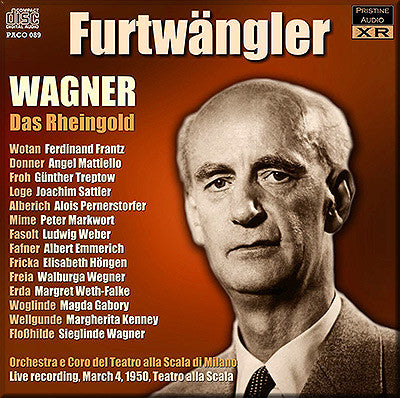
This album is included in the following sets:
This set contains the following albums:
- Producer's Note
- Full Cast Listing
- Cover Art
Furtwängler's 1950 Ring Cycle starts here - Part 1: Das Rheingold
XR remastering brings vivid depth and astonishing power to Wagner's epic operas
Ever since I began working on Furtwängler's other Ring cycle (RAI, 1953) I have received requests to follow it with this one, recorded live at La Scala in Milan in 1950. Thus what seems almost to have become something of an annual event begins again: Pristine's historic Ring for 2013, another "best ever" contender that's suffered from any number of dire-sounding releases in the past. With Richard Wagner's 200th birthday this year in mind, here's the start of this 32-bit XR remastered Ring.
Initial soundings last year suggested that this recording would respond well to the rigours of the various XR processes, as it has - indeed, better than I'd dared hope. Wagner really does need a full, rich and all-enveloping sound, and at last we're able to hear it in this performance. It's not entirely uniform - there are a handful of short sections where the quality drops slightly - but overall this offers a pretty amazing improvement in audio quality. I've also excised a lot of bumps, coughs and other noises to help provide as involving a musical experience, with as few distractions, as possible.
Your musical journey starts here...
Andrew Rose
WAGNER - Das Rheingold WWV 86A
Wotan Ferdinand Frantz
Donner Angel Mattiello
Froh Günther Treptow
Loge Joachim Sattler
Alberich Alois Pernerstorfer
Mime Peter Markwort
Fasolt Ludwig Weber
Fafner Albert Emmerich
Fricka Elisabeth Höngen
Freia Walburga Wegner
Erda Margret Weth-Falke
Woglinde Magda Gabory
Wellgunde Margherita Kenney
Floßhilde Sieglinde Wagner
Orchestra e Coro del Teatro alla Scala di Milano
conductor Wilhelm Furtwängler
Live recording, March 4, 1950, Teatro alla Scala
Fanfare Review
Now that Andrew Rose of Pristine has gotten around to it, the result achieves a level that frankly I never thought possible
Different restoration engineers keep improving the Furtwängler/Scala Ring cycle, and now that Andrew Rose of Pristine has gotten around to it, the result achieves a level that frankly I never thought possible.
As followers of conductor Wilhelm Furtwängler know, there are two complete Ring cycle recorded performances of his. One is from fully staged 1950 performances at La Scala in Milan, and the other is a broadcast unstaged set of performances, recorded one act at a time, for the Rome RAI in 1953. I have reviewed one or the other of these three times in Fanfare (20:2 for the Music & Arts release of the Scala performances, and 33:1 for the Archipel improvement on that effort; 29:6 for the Gebhardt release of the RAI set). William Youngren also reviewed the EMI release of the RAI set in Fanfare 14:4.
For many years the Rome RAI set was preferable because of superior sound quality. It was, after all, produced for radio broadcast. In addition, the performers were able to retain freshness throughout, since they were only performing one act on any given evening, and they did not have to trouble themselves with stage business. Some of us always had a sneaking suspicion that the Scala performances were more satisfying, because they had that sizzle and specificity of inflection that comes from fully staged performances of music dramas, but the limited sonic reproduction made it hard to really enjoy them. The first release of the Scala Ring that provided real listening pleasure was the Archipel (a label with an uneven history, but one that did a fine job here). Now, however, things have moved up yet another whole level.
Any of those earlier reviews, easily locatable on the Fanfare Archive, will give you the specifics of why I believe that anyone seriously interested in The Ring must know Furtwängler’s performances, and why I think that of the two the Scala set is preferable. If there ever was any doubt of this, Pristine Audio’s transfer removes it. This is, in fact, a remarkably lifelike reproduction of a performance that when first heard decades ago on a poor LP transfer seemed like something one would never actually be able to take much pleasure in. By the time you read this, the entire Ring cycle will be available from Pristine, and it is urgently recommended even if you own one of the earlier transfers. I have listened to it in both monaural and the XR stereo versions (this release is in the latter)—both are satisfying. I slightly prefer the XR stereo—which is not at all like the fake stereo of the 1970s, but simply a way of allowing the ambience to feel more natural.
Henry Fogel
This article originally appeared in Issue 37:1 (Sept/Oct 2013) of Fanfare Magazine.

